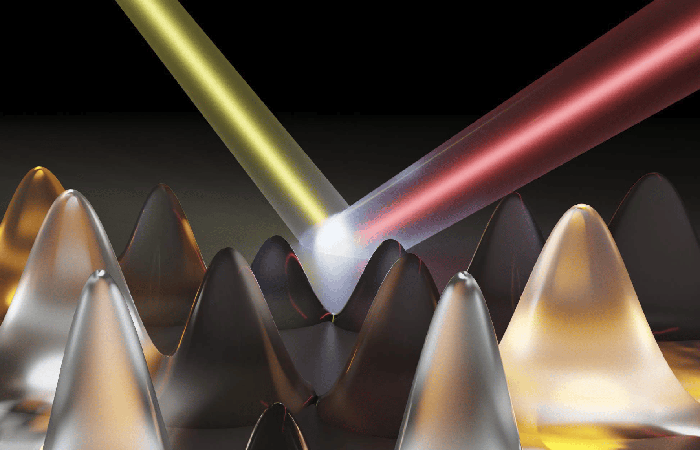Markus Borsch receives ProQuest Distinguished Dissertation Award for research on lightwave electronics
With his dissertation, Borsch takes on the unknown and enables the future of solid-state quantum electronics.Blue PHOLEDs: Final color of efficient OLEDs finally viable in lighting
Synchronizing light and matter adds blue to the OLED color palette
Nextgen computing: Hard-to-move quasiparticles glide up pyramid edges
Computing with a combination of light and chargeless excitons could beat heat losses and more, but excitons need new modes of transportShaping the quantum future with lightwave electronics
The semiconductor-compatible technology is a million times faster than existing electronics and could give us access to an entire new world of quantum phenomena.Soon-to-be most powerful laser in the US is open for experiments
The NSF-supported facility at U-M is about to begin welcoming researchers to study extreme physics that could advance medicine, microelectronics and more.Inside the Quantum Research Institute
Mack Kira, co-director of the Quantum Research Institute with Steven Cundiff, is ready to take Michigan’s quantum activities to the next level.New undergraduate courses prepare students for the Second Quantum Revolution
Quantum information science and engineering is one of the hottest fields in engineering – and ECE wants to make it accessible to everyone.Quantum entanglement could make accelerometers and dark matter detectors more precise
And yes, they are looking to miniaturize it for smartphone dead reckoning.Nanoscale ferroelectric semiconductor could power AI and post-Moore’s Law computing on a phone
Next-gen computing material gets down to the right size for modern manufacturing.Mohammad Aamir Sohail awarded inaugural Quad Fellowship in recognition of his excellence in quantum research and international cooperation
Sohail, a PhD student, is one of four U-M students to receive the fellowship, which is given to top graduate students from Australia, India, Japan, and the United States.Seeing electron movement at fastest speed ever could help unlock next-level quantum computing
New technique could enable processing speeds a million to a billion times faster than today’s computers and spur progress in many-body physics.Emulating impossible “unipolar” laser pulses paves the way for processing quantum information
Quantum materials emit light as though it were only a positive pulse, rather than a positive-negative oscillation.Touheed Anwar Atif awarded Rackham Predoctoral Fellowship for his research on quantum information and quantum computing
Atif’s coding framework addresses quantum information network coding problems and has helped uncover new insights into the world of quantum information.‘Exciton surfing’ could enable next-gen energy, computing and communications tech
A charge-neutral information carrier could cut energy waste from computing, now that it can potentially be transported within chips.Quantum tech: Semiconductor “flipped” to insulator above room temp
Discovery could pave the way to high speed, low-energy quantum computing.U-M forms collaboration to advance quantum science and technology
The Midwest Quantum Collaboratory studies quantum science and technology.Research full speed ahead on manufacturable III-V materials for next-generation electronics
A recent breakthrough in ferroelectric III-V semiconductors at the University of Michigan has been followed by several advancements and new funding to bring the technology closer to market.$1.8M to develop room temperature, controllable quantum nanomaterials
The project could pave the way for compact quantum computing and communications as well as efficient UV lamps for sterilization and air purification.“Egg carton” quantum dot array could lead to ultralow power devices
By putting a twist on new “2D” semiconductors, researchers have demonstrated their potential for using single photons to transmit information.
Mapping quantum structures with light to unlock their capabilities
Rather than installing new “2D” semiconductors in devices to see what they can do, this new method puts them through their paces with lasers and light detectors.
The new quantum spurs action by the Michigan Quantum Science & Technology Working Group
The new working group showcased Michigan’s strength in Quantum Science at a workshop attended by researchers throughout the University of Michigan.
It takes two photonic qubits to make quantum computing possible
Professors Ku and Steel are applying their expertise to take key next steps toward practical quantum computing
Blue Sky: Up to $10M toward research so bold, some of it just might fail
Inspired by startup funding models, Michigan Engineering reinvents its internal R&D grant structure.
Light could make semiconductor computers a million times faster or even go quantum
Electron states in a semiconductor, set and changed with pulses of light, could be the 0 and 1 of future “lightwave” electronics or room-temperature quantum computers.
‘Photon glue’ enables a new quantum mechanical state
Researchers at the University of Michigan and Queens College used light to create links between organic and inorganic semiconductors in an optical cavity.
A new laser paradigm: An electrically injected polariton laser
“It is no longer a scientific curiosity. It’s a real device.”
Advancing secure communications: A better single-photon emitter for quantum cryptography
The new device improves upon the current technology and is much easier to make.
Scientific Milestone: A room temperature Bose-Einstein condensate
A BEC is an unusual state of matter in which a group of boson particles can exist in a single quantum state, allowing scientists to observe novel quantum phenomena.
Organic laser breakthrough
The team is working toward building organic lasers that, like many inorganic lasers today, can be excited with electricity rather than light.
Duncan Steel will advance quantum information processes in new MURI
Steel will concentrate his efforts on solid state systems, specifically with epitaxially grown InAs/lGaAs semiconductor quantum dots.
 MENU
MENU 

